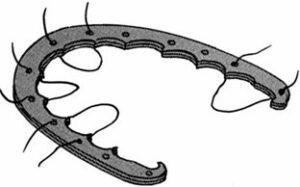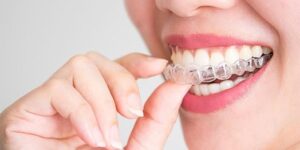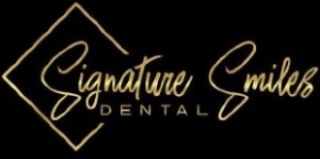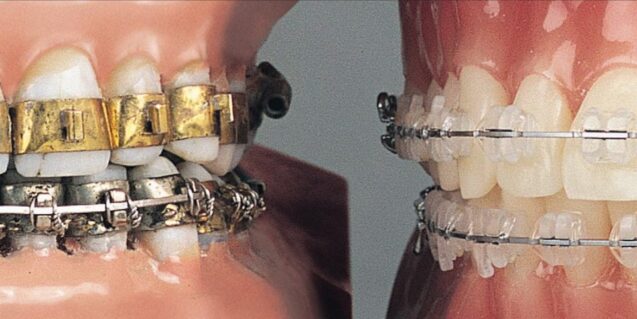The History of Braces
Throughout our history as the human race, beauty and health regimes have gone in and out of trend; however, one constant has been the desire for straight teeth and subsequent techniques practised and developed over thousands of years.
Ancient History
 The history of orthodontic work goes back well beyond 100BC, leaving us with almost unrecognisable precursors.
The history of orthodontic work goes back well beyond 100BC, leaving us with almost unrecognisable precursors.
Many ancient civilisations, such as Ancient Greece, Rome and Egypt began focusing on oral cosmetics through teeth alignment; the oldest record being from Ancient Egypt.
Archaeologists have discovered intricate structures of metal bound around the teeth of Egyptian mummies. As clear in the image above, the use of contraptions similar would’ve been not only extremely painful but also inconvenient. Orthodontic devices like these are thought to only have been seen on extremely wealthy individuals, including Cleopatra. There is also evidence to suggest that these contraptions were often applied after the death of the individual. The societal significance of being able to afford such a procedure had been believed to be highly beneficial when entering the afterlife. This ideology of braces benefiting you in the afterlife was not carried through into modern orthodontics.
1700s
 It wasn’t until the 1700s that orthodontic work progressed significantly, being particularly prevalent in France. New practices such as the removal of ‘third molars’ (wisdom teeth) had become common. With credit to French researcher, Pierre Fauchard (publisher of The Surgeon Dentist; or Treatise on the Teeth), the concept of wires and brackets restrained to the teeth was explored. This was further supported by his invention of ‘the bandeau’ (a metal horse shoe shaped frame bound to the teeth), along with other cosmetic devices such as bridges. The bandeau acknowledged the desire for round symmetrical teeth alignment, and used a simple device (as shown in the image above) to force teeth movement into the mould.
It wasn’t until the 1700s that orthodontic work progressed significantly, being particularly prevalent in France. New practices such as the removal of ‘third molars’ (wisdom teeth) had become common. With credit to French researcher, Pierre Fauchard (publisher of The Surgeon Dentist; or Treatise on the Teeth), the concept of wires and brackets restrained to the teeth was explored. This was further supported by his invention of ‘the bandeau’ (a metal horse shoe shaped frame bound to the teeth), along with other cosmetic devices such as bridges. The bandeau acknowledged the desire for round symmetrical teeth alignment, and used a simple device (as shown in the image above) to force teeth movement into the mould.
Fauchard was also responsible for the revelation that his studies on orthodontics were better demonstrated on children, due to their undeveloped teeth roots. Fauchard passed away in 1761, but his legacy led to huge developments in the orthodontic industry for many decades to come.
Late 1800s
In the late 1800s, the use of rubber bands were popularised in the orthodontic industry.
The ‘wire crib’ became the standard device used for straightening teeth, marking the start of modern orthodontics. The common procedure consisted of the wire crib, bound by rubber bands which were periodically tightened. This concept of small adjustments over periods of time resulted in a slightly less painful procedure. The inclusion of elastics also began practise in the late 19th century, for bettering jaw position, facilitating for further accuracy in the alignment of the teeth.
1900s
 During the 20th century much of the orthodontic routine mirrored that of today, with the use of impressions for more acute analysis, the frequent of X-rays. A range of materials were used in orthodontics, from organic materials, such as and wood and ivory, to the preferred, but expensive, materials such as silver and gold. Due to the properties of gold, its malleability made it the seemingly perfect candidate; however the expense limited its demand to wealthier classes.
During the 20th century much of the orthodontic routine mirrored that of today, with the use of impressions for more acute analysis, the frequent of X-rays. A range of materials were used in orthodontics, from organic materials, such as and wood and ivory, to the preferred, but expensive, materials such as silver and gold. Due to the properties of gold, its malleability made it the seemingly perfect candidate; however the expense limited its demand to wealthier classes.
The 1900s was also responsible for term ‘braces’. Derived from the French root word ‘bracier’, (meaning to restrain, hold tightly to something) ‘braces’ was born.
2000s
 Finally we have reached the familiar modern day braces. With quick treatment durations (spanning from a few months to a few years), and significantly less painful technologies; the slight discomfort associated with modern day braces is truly overlooked. The treatment of orthodontic work is more accessible than ever before, with reduced prices and an increase in practices. With over 60% of Australians considering or undertaking orthodontic treatment, the rise of the industry has resulted in 552 orthodontic practices just within the country.
Finally we have reached the familiar modern day braces. With quick treatment durations (spanning from a few months to a few years), and significantly less painful technologies; the slight discomfort associated with modern day braces is truly overlooked. The treatment of orthodontic work is more accessible than ever before, with reduced prices and an increase in practices. With over 60% of Australians considering or undertaking orthodontic treatment, the rise of the industry has resulted in 552 orthodontic practices just within the country.
Typical modern day braces consist of brackets (typically made of stainless steel), which are bonded using adhesive to the teeth. A wire which is threaded through the brackets is bound on with elastic bands. The pressure provided through the wire is what initiates the movement of the teeth.
Moving on from traditional braces, we have the new and flashy ‘Invisalign’ or aligners. Invisalign was the first company to produce clear aligners. Founded in 1998 by at the time university student Zia Chishti, Invisalign has sky rocketed, with many other companies creating similar products, such as ClearCorrect.
Aligners have been popular since introduced to the market due to the cosmetic benefit, especially compared to its predecessor; traditional braces. With a very similar price to traditional braces, they remain an accessible option.
However at this stage, aligners are a slightly less flexible option. Those with a cross bite, a large under bite or a large overbite sometimes face more difficulty pursuing this route.
As we look forward into the future of orthodontic treatment, we can predict treatment durations and prices reducing. With an overall predicted growth of 11% in dentists (2018-2028), the future of dentistry will be able to facilitating more research and more advancement giving us lots to look forward to.
References
A Historical Timeline of Orthodontics
The History of Orthodontics: From Ancient Braces to Invisalign
Pierre Fauchard the Father of Modern Dentistry
Advances In Dentistry, 1900-1949
Pioneers and Milestones in the Field of Orthodontics
Oral Health and Dental Care in Australia
Invisalign: Teeth Straightening with Clear, Nearly Invisible Braces
More

